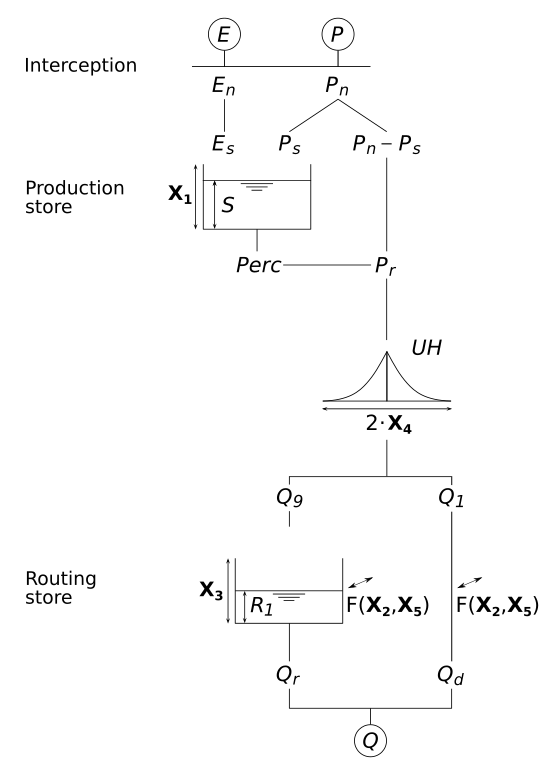HydPy-G-GR5 (Génie Rural model with 5 parameters)¶
The GR5 model (modèle du Génie Rural à 5 parametres Journalier) is a daily lumped
five-parameter rainfall-runoff model and belongs to the family of soil moisture
accounting models. It was initially published by Le Moine (2008) and is a
modification of GR4J. Our implementation, gland_gr5, follows the one of the R
package airGR (Coron et al., 2017) but with a few extensions that we explain in the
documentation of gland_gr4, which implements and extends GR4J.
The main differences between GR5 and GR4 are that GR5 only applies a single Unit
Hydrograph and uses a fifth parameter, X5, to allow for a more flexible configuration
of the groundwater exchange term. In gland_gr5, one can choose between different
types of runoff concentration submodels, as explained for gland_gr4.
The following figure (Coron et al., 2023) shows the general structure of
gland_gr5:

Integration tests¶
Note
When new to HydPy, consider reading section Integration Tests first.
The settings of the following tests are similar to the ones of application model
gland_gr4. Hence, comparing the test results gives a good impression of the
functional differences between both models.
The following settings are identical:
>>> from hydpy import pub
>>> pub.timegrids = "1990-01-01", "1990-02-20", "1d"
>>> from hydpy.models.gland_gr5 import *
>>> parameterstep("1d")
>>> from hydpy import Element
>>> land = Element("land", outlets="outlet")
>>> land.model = model
>>> area(360.0)
>>> with model.add_petmodel_v1("evap_ret_io"):
... evapotranspirationfactor(1.0)
>>> from hydpy import IntegrationTest
>>> test = IntegrationTest(land)
>>> test.plotting_options.axis1 = inputs.p, fluxes.e, fluxes.qh
>>> test.dateformat = "%d.%m."
>>> inputs.p.series = (
... 0.0, 9.3, 3.2, 7.3, 0.0, 0.0, 0.0, 0.0, 0.1, 0.2, 2.9, 0.2, 0.0, 0.0, 0.0, 3.3,
... 4.6, 0.8, 1.8, 1.1, 0.0, 5.0, 13.1, 14.6, 4.0, 0.8, 0.1, 3.3, 7.7, 10.3, 3.7,
... 15.3, 3.2, 2.7, 2.2, 8.0, 14.3, 6.3, 0.0, 5.9, 9.2, 6.1, 0.1, 0.0, 2.8, 10.6,
... 8.8, 7.2, 4.9, 1.8
... )
>>> model.petmodel.sequences.inputs.referenceevapotranspiration.series = (
... 0.3, 0.4, 0.4, 0.3, 0.1, 0.1, 0.1, 0.2, 0.2, 0.3, 0.3, 0.2, 0.2, 0.2, 0.2, 0.3,
... 0.3, 0.2, 0.2, 0.3, 0.2, 0.2, 0.3, 0.6, 0.4, 0.4, 0.4, 0.5, 0.4, 0.3, 0.3, 0.5,
... 0.5, 0.3, 0.3, 0.4, 0.4, 0.3, 0.2, 0.1, 0.1, 0.0, 0.1, 0.1, 0.0, 0.2, 0.9, 0.9,
... 0.5, 0.9
... )
base example¶
The following parameter values do not agree with the ones of the
base example on application model gland_gr4 but with the ones of
the example given by Coron et al. (2023):
>>> imax(0.0)
>>> x1(245.918)
>>> x2(1.027)
>>> x3(90.017)
>>> x5(0.434)
>>> with model.add_rconcmodel_v1("rconc_uh"):
... uh("gr_uh2", x4=2.198)
>>> test.inits = (
... (states.i, 0.0),
... (states.s, 0.3 * x1),
... (states.r, 0.5 * x3),
... (model.rconcmodel.sequences.logs.quh, 0.0),
... )
The following simulation results agree with those of the GR5J airGR implementation:
>>> conditions = test("gland_gr5_base_example", get_conditions="1990-01-01")
Click to see the table
Click to see the graphThere is no indication of an error in the water balance:
>>> from hydpy import round_
>>> round_(model.check_waterbalance(conditions))
0.0
groundwater loss¶
This integration test corresponds to the groundwater loss example on
gland_gr4:
>>> x2(-1.027)
>>> test.inits.s = 0.0
>>> test.inits.r = 0.0
>>> conditions = test("gland_gr5_groundwater_loss", get_conditions="1990-01-01")
Click to see the table
Click to see the graphThere is no indication of an error in the water balance:
>>> round_(model.check_waterbalance(conditions))
0.0
interception¶
This integration test corresponds to the interception example on
gland_gr4:
>>> imax(10.0)
>>> x2(1.027)
>>> test.inits.s = 0.3 * x1
>>> test.inits.r = 0.5 * x3
>>> conditions = test("gland_gr5_interception", get_conditions="1990-01-01")
Click to see the table
Click to see the graphThere is no indication of an error in the water balance:
>>> round_(model.check_waterbalance(conditions))
0.0
no rconc submodels¶
This integration test corresponds to the no rconc submodels example on
gland_gr4:
>>> model.rconcmodel = None
>>> conditions = test("gland_gr5_no_rconc_submodels", get_conditions="1990-01-01")
Click to see the table
Click to see the graphThere is no indication of an error in the water balance:
>>> round_(model.check_waterbalance(conditions))
0.0
- class hydpy.models.gland_gr5.Model[source]¶
Bases:
Main_PETModel_V1,Main_RConcModel_V1HydPy-G-GR5 (Génie Rural model with 5 parameters).
- The following “run methods” are called in the given sequence during each simulation step:
Calc_E_V1Let a submodel that conforms to thePETModel_V1interface calculate the potential evapotranspiration.Calc_EI_V1Calculate the actual evaporation from the interception store.Calc_PN_V1Calculate the net precipitation by considering all interception losses.Calc_EN_V1Calculate the net evapotranspiration capacity by considering interception evaporation.Update_I_V1Update the interception store based on precipitation, net precipitation, and interception evaporation.Calc_PS_V1Calculate the part of net precipitation filling the production store.Calc_ES_V1Calculate the actual evapotranspiration from the production store.Update_S_V1Update the production store by adding precipitation and evapotranspiration.Calc_Perc_V1Calculate the percolation from the production store.Update_S_V2Update the production store by subtracting percolation.Calc_AE_V1Calculate the total actual evapotranspiration.Calc_Pr_V1Calculate the total inflow into the runoff concentration module.Calc_Q10_V1TransformPRintoQ10.Calc_Q1_Q9_V2CalculateQ1andQ9by splittingQ10.Calc_FR_V2Calculate the groundwater exchange affecting the routing store according to GR5 and GR6.Update_R_V1Update the level of the non-linear routing store by adding its inflows according to GR4 and GR5.Calc_QR_V1Calculate the outflow of the routing store.Update_R_V3Update the non-linear routing store by subtracting its outflow.Calc_FD_V1Calculate the groundwater exchange affecting the direct runoff.Calc_QD_V1Calculate the direct runoff.Calc_QH_V1Calculate the total runoff according to GR4 and GR5.Calc_QV_V1Calculate total discharge in m³/s.
- The following “outlet update methods” are called in the given sequence at the end of each simulation step:
Pass_Q_V1Update the outlet link sequence.
- The following “additional methods” might be called by one or more of the other methods or are meant to be directly called by the user:
Calc_E_PETModel_V1Let a submodel that conforms to thePETModel_V1interface calculate the potential evapotranspiration.Calc_Q_RConcModel_V1Let a submodel that follows theRConcModel_V1submodel interface perform runoff concentration.
- Users can hook submodels into the defined main model if they satisfy one of the following interfaces:
PETModel_V1Simple interface for calculating all potential evapotranspiration values in one step.RConcModel_V1Simple interface for calculating runoff concentration processes.
- petmodel: modeltools.SubmodelProperty¶
Required submodel that complies with the following interface: PETModel_V1.
- rconcmodel: modeltools.SubmodelProperty¶
Optional submodel that complies with the following interface: RConcModel_V1.
- check_waterbalance(initial_conditions: dict[str, dict[str, dict[str, float | ndarray[tuple[Any, ...], dtype[float64]]]]]) float[source]¶
Determine the water balance error of the previous simulation run in mm.
Method
check_waterbalance()calculates the balance error as follows:\[\begin{split}Error = \Sigma InOut - \Delta Vol - \Delta Rconc \\ \\ \Sigma InOut = \sum_{t=t0}^{t1} P_t - AE_t + FR_t + FD_t - QH_t \\ \Delta Vol = \left( I_{t1} - I_{t0} \right) + \left( S_{t1} - S_{t0} \right) + \left( R_{t1} - R_{t0} \right) \\ \Delta Rconc = get\_waterbalance_{runof\!f \ concentration}(*)\end{split}\]
- REUSABLE_METHODS: ClassVar[tuple[type[ReusableMethod], ...]] = ()¶
- class hydpy.models.gland_gr5.ControlParameters(master: Parameters, cls_fastaccess: type[FastAccessParameter] | None = None, cymodel: CyModelProtocol | None = None)¶
Bases:
SubParametersControl parameters of model gland_gr5.
- The following classes are selected:
Area()Subbasin area [km²].IMax()Interception store capacity [mm].X1()Maximum capacity of the production storage [mm].X2()Groundwater exchange coefficient (positive for water imports, negative for exports) [mm/T].X3()One timestep ahead maximum capacity of the routing store [mm].X5()Intercatchment exchange threshold [-].
- class hydpy.models.gland_gr5.DerivedParameters(master: Parameters, cls_fastaccess: type[FastAccessParameter] | None = None, cymodel: CyModelProtocol | None = None)¶
Bases:
SubParametersDerived parameters of model gland_gr5.
- class hydpy.models.gland_gr5.FluxSequences(master: Sequences, cls_fastaccess: type[TypeFastAccess_co] | None = None, cymodel: CyModelProtocol | None = None)¶
Bases:
FluxSequencesFlux sequences of model gland_gr5.
- The following classes are selected:
E()Potential evapotranspiration [mm/T].EN()Net evapotranspiration capacity [mm/T].PN()Net precipitation [mm/T].EI()Actual evaporation from the interception store [mm/T].ES()Actual evapotranspiration from the production store [mm/T].AE()Total actual evapotranspiration [mm/T].PR()Total inflow into the runoff concentration module [mm/T].Q10()Total outflow of runoff concentration module [mm/T].Perc()Percolation [mm/T].Q9()Outflow of runoff concentration submodel receivingPR9[mm/T].Q1()Outflow of runoff concentration submodel receivingPR1[mm/T].FD()Groundwater exchange affecting the direct runoff [mm/T].FR()Groundwater exchange affecting the routing store [mm/T].QR()Outflow of the routing store [mm/T].QD()Direct runoff [mm/T].QH()Total runoff [mm/T].QV()Total discharge [m³/s].
- class hydpy.models.gland_gr5.InputSequences(master: Sequences, cls_fastaccess: type[TypeFastAccess_co] | None = None, cymodel: CyModelProtocol | None = None)¶
Bases:
InputSequencesInput sequences of model gland_gr5.
- The following classes are selected:
P()Precipitation [mm/T].
- class hydpy.models.gland_gr5.OutletSequences(master: Sequences, cls_fastaccess: type[TypeFastAccess_co] | None = None, cymodel: CyModelProtocol | None = None)¶
Bases:
OutletSequencesOutlet sequences of model gland_gr5.
- The following classes are selected:
Q()Runoff [m³/s].
- class hydpy.models.gland_gr5.StateSequences(master: Sequences, cls_fastaccess: type[TypeFastAccess_co] | None = None, cymodel: CyModelProtocol | None = None)¶
Bases:
StateSequencesState sequences of model gland_gr5.
